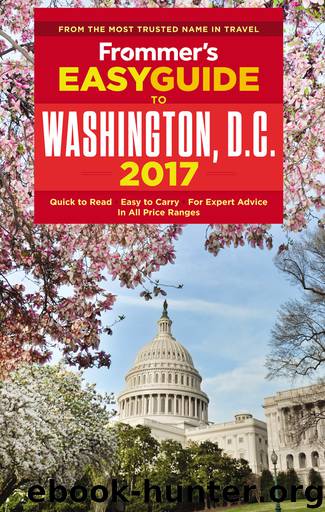Frommer's EasyGuide to Washington, D.C. 2017 by Elise Hartman Ford

Author:Elise Hartman Ford
Language: eng
Format: epub
Publisher: FrommerMedia
Published: 2016-10-27T04:00:00+00:00
An Act of Congress in 1790 established the city now known as Washington, District of Columbia, as the seat of the federal government. George Washington and city planner Pierre L’Enfant chose the site for the president’s house and staged a contest to find a builder. Although Washington picked the winner—Irishman James Hoban—he was the only president never to live in the White House. The structure took 8 years to build, starting in 1792, when its cornerstone was laid. Its facade is made of the same stone used to construct the Capitol. The mansion quickly became known as the “White House,” thanks to the limestone whitewashing applied to the walls to protect them, later replaced by white lead paint in 1818. In 1814, during the War of 1812, the British set fire to the White House and gutted the interior; the exterior managed to endure only because a rainstorm extinguished the fire. What you see today is Hoban’s basic creation: a building modeled after an Irish country house (in fact, Hoban had in mind the house of the Duke of Leinster in Dublin).
Note: Tours of the White House exit from the North Portico. Before you descend the front steps, look to your left to find the window whose sandstone sill remains unpainted as a reminder both of the 1814 fire and of the White House’s survival.
Additions over the years have included the South Portico in 1824, the North Portico in 1829, and electricity in 1891, during Benjamin Harrison’s presidency. In 1902, repairs and refurnishing of the White House cost nearly $500,000. No other great change took place until Harry Truman’s presidency, when the interior was completely renovated after the leg of Margaret Truman’s piano cut through the dining room ceiling. The Trumans lived at Blair House across the street for nearly 4 years while the White House interior was shored up with steel girders and concrete.
In 1961, First Lady Jacqueline Kennedy spearheaded the founding of the White House Historical Association and formed a Fine Arts Committee to help restore the famous rooms to their original grandeur, ensuring treatment of the White House as a museum of American history and decorative arts. “It just seemed to me such a shame when we came here to find hardly anything of the past in the house, hardly anything before 1902,” Mrs. Kennedy observed.
Every president and first family put their own stamp on the White House. The Obamas installed artworks on loan from the Hirshhorn Museum and from the National Gallery of Art in their private residence, and chose works to hang in the public rooms of the White House. (Changing the art in the public rooms requires approval from the White House curator and the Committee for the Preservation of the White House.) Michelle Obama planted a vegetable garden on the White House grounds, and President Obama altered the outdoor tennis court so that it could be used for both basketball and tennis games.
Highlights of the public tour include the gold and white East
Download
This site does not store any files on its server. We only index and link to content provided by other sites. Please contact the content providers to delete copyright contents if any and email us, we'll remove relevant links or contents immediately.
Giovanni's Room by James Baldwin(6820)
The Plant Paradox by Dr. Steven R. Gundry M.D(2435)
The Stranger in the Woods by Michael Finkel(2330)
Miami by Joan Didion(2166)
Wild: From Lost to Found on the Pacific Crest Trail by Cheryl Strayed(2144)
INTO THE WILD by Jon Krakauer(2087)
Trail Magic by Trevelyan Quest Edwards & Hazel Edwards(2064)
DK Eyewitness Top 10 Travel Guides Orlando by DK(2059)
Vacationland by John Hodgman(2034)
The Twilight Saga Collection by Stephenie Meyer(2029)
Nomadland by Jessica Bruder(1960)
Birds of the Pacific Northwest by Shewey John; Blount Tim;(1876)
The Last Flight by Julie Clark(1839)
Portland: Including the Coast, Mounts Hood and St. Helens, and the Santiam River by Paul Gerald(1821)
On Trails by Robert Moor(1795)
Deep South by Paul Theroux(1718)
Blue Highways by William Least Heat-Moon(1664)
Trees and Shrubs of the Pacific Northwest by Mark Turner(1646)
1,000 Places to See in the United States and Canada Before You Die (1,000 Places to See in the United States & Canada Before You) by Patricia Schultz(1558)
